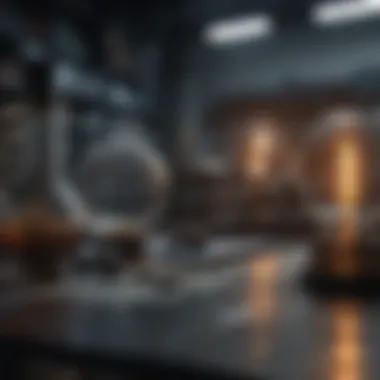The Role of a Topflash Reporter in Scientific Communication


Intro
In the contemporary landscape of scientific communication, the role of a Topflash Reporter has gained prominence. This role not only requires expertise in science but also demands a keen understanding of communication strategies that shape public perception and knowledge. As news travels swiftly, Topflash Reporters serve as the bridge between complex scientific concepts and the general audience, translating intricate findings into accessible formats. This article delves into the responsibilities, skills, and technological advancements characterizing this vital position, offering a comprehensive insight into how these reporters navigate their tasks.
Research Highlights
Key Findings
The responsibilities of a Topflash Reporter extend beyond simple reporting. They must critically assess scientific research, verify data, and present findings in a manner that upholds accuracy and integrity. They play a crucial role in:
- Real-time Reporting: Timeliness is paramount in science news; hence, these reporters often work under tight deadlines, delivering information that many stakeholders rely upon.
- Critical Evaluation: They sift through vast amounts of data, ensuring only reliable sources inform their narratives. Quality control is essential.
- Engagement with Experts: Collaboration with scientists and researchers enables Topflash Reporters to clarify and contextualize findings.
Implications and Applications
The influence of Topflash Reporters extends to various fields:
- Public Understanding of Science: By making research comprehensible, they enhance the public’s knowledge and interest in science.
- Policy Influence: Accurate reporting can inform policy decisions, guiding public health responses, environmental initiatives, and more.
"Topflash Reporters are not just messengers; they are critical interpreters of scientific knowledge."
The Evolution of Science Reporting
Over decades, science reporting has shifted remarkably. Initially focused on lengthy articles in print media, it now encompasses digital platforms where immediacy and accessibility are vital. Social media, blogs, and podcasts are avenues where Topflash Reporters share findings. This transition requires adaptation in storytelling techniques that cater to evolving audience preferences and expectations.
Skills and Challenges
Being a Topflash Reporter involves a unique skill set:
- Strong Writing Skills: Effective storytelling that retains essential scientific details.
- Analytical Skills: Ability to interpret data and assess research quality critically.
- Technical Proficiency: Familiarity with new media tools and platforms enhances reach and communication.
However, they face several challenges:
- Information Overload: The sheer volume of studies published can be paralyzing, making it hard to discern what is most relevant.
- Managing Misinformation: As information spreads rapidly, ensuring accuracy in reporting becomes increasingly complex.
The End
Topflash Reporters embody a reassuring presence amidst the fast-paced world of scientific communication. Their ability to synthesize intricate data into digestible formats fosters a greater understanding of crucial scientific issues. As this sector continues to evolve, so too will the practices and responsibilities of those who report on it, emphasizing the need for ongoing adaptation in a changing media landscape.
Understanding the Topflash Reporter
In today's fast-paced world of scientific communication, the role of a Topflash Reporter is increasingly critical. This profession melds the need for accurate, timely reporting with the dynamic nature of research and scientific discoveries. By interpreting complex data and events quickly, the Topflash Reporter acts as an essential bridge between the scientific community and the public.
Definition and Purpose
The Topflash Reporter is primarily tasked with delivering concise, immediate updates about significant scientific developments. Their work consists of summarizing research findings, breaking studies, or newsworthy events rapidly. The purpose of this role is not merely to inform but to provide context that enables the audience to grasp the implications of new scientific knowledge.
These reporters are skilled in identifying which pieces of information are most relevant and how best to communicate them. They often utilize various platforms, including online journals, social media, and institutional press releases, to disseminate content. The immediacy of their work ensures that both scientists and the public stay updated with the latest advancements in various fields, including medicine, technology, and environmental science.
Historical Context


Historically, science reporting evolved alongside major breakthroughs in various disciplines. In the early days, scientific reports appeared primarily in academic journals, inaccessible to the general public. Reports weren’t timely and often lacked context. However, as science grew more influential in daily life, the demand for accessible information increased.
Periodicals and later, digital platforms began to emerge, allowing for a broader dissemination of scientific knowledge. During the 20th century, the advent of radio and television changed how science was communicated, leading to the introduction of science journalists who could encapsulate complex reports into digestible segments for the audience.
With the rise of the internet, the landscape transformed even further, giving birth to the Topflash Reporter, whose necessity is underscored by the rapid accessibility of information.
Evolution of the Role
The evolution of the Topflash Reporter parallels advancements in technology and communication methods. Initially, reporters relied on firsthand interviews and written reports from scientists. As technology improved, access to data became quicker, allowing reporters to pull information in real time.
The introduction of digital tools greatly impacted their capabilities. Now, Topflash Reporters employ social media, data analysis software, and visualization tools to enhance their reporting, making it more engaging and informative. The role is continually adapting; today, Topflash Reporters need not only great writing skills but also proficiency in technology and an understanding of ethical reporting standards.
Core Responsibilities
The role of a Topflash Reporter is fundamentally characterized by a variety of core responsibilities that establish their contribution to scientific communication. These responsibilities not only demand a keen understanding of scientific topics but also the ability to convey complex information in a digestible format. Key aspects include research and analysis, creating informative content, and employing real-time reporting techniques. Each of these elements is integral to the efficacy and credibility of a Topflash Reporter’s work.
Research and Analysis
Research and analysis are cornerstones in the practice of a Topflash Reporter. This process begins with identifying credible sources relevant to current scientific discussions or discoveries. Reporters must be proficient at navigating through an immense sea of information, often distinguishing peer-reviewed articles from less reputable publications. This means employing critical thinking to assess the validity and reliability of the available data.
Moreover, analyzing data and trends in scientific research allows journalists to provide context to their audience. Their analysis translates intricate scientific jargon into language that is understandable and engaging without oversimplifying critical details. For example, a Topflash Reporter might analyze new findings about climate change and relate them to existing knowledge in a way that highlights their significance. This is essential in fostering an informed public that can engage with science meaningfully.
Creating Informative Content
Once research is completed, the next crucial step is creating informative content. A Topflash Reporter must articulate facts and insights in a cohesive manner. This involves writing articles, developing blog posts, and producing multimedia content that resonates with both lay readers and experts in the field. Clarity and precision in language are required, as the intended audience often spans diverse educational backgrounds.
Informative content produced by Topflash Reporters should include an overview, analysis, and implications of the research discussed. It may also involve crafting narratives that illuminate the human elements behind scientific discoveries. By doing so, they not only inform but also engage their audience, making science more relatable.
Here are key features that should be present in their content:
- Clear headlines that summarize the main idea.
- Well-organized paragraphs that allow for easy reading.
- Citation of credible sources to enhance trustworthiness.
- Inclusion of visuals where appropriate to aid comprehension.
Real-Time Reporting Techniques
In the age of instant news, real-time reporting has become indispensable. Topflash Reporters need to implement efficient reporting techniques that allow them to disseminate important findings as they emerge. This can involve live updates during scientific conferences, utilizing social media platforms, or employing blogs for rapid news distribution.
Real-time reporting requires that reporters are adept in responsive communication. They must be able to distill information quickly while maintaining accuracy and relevance in their reporting. This often means being prepared to clarify or update previously reported information as new discoveries surface. For instance, when a critical health study is released, a Topflash Reporter's ability to report findings swiftly while ensuring factual accuracy is vital.
The use of tools like content management systems makes this task easier, enabling the handling of fast-paced news efficiently. As technology advances, so does the potential for real-time interaction with audiences, allowing reporters to directly answer questions, fostering immediate engagement.
"The duty of a Topflash Reporter goes beyond simply reporting; it is about creating a bridge between science and the public."
Skills Required for Topflash Reporting
In the realm of modern scientific communication, the role of a Topflash Reporter demands a diverse set of skills. These skills are essential because they directly influence the quality and reliability of information presented to the audience. A proficient Topflash Reporter not only conveys information effectively but also ensures that such information is accurate, timely, and relevant. The landscape of science journalism is competitive and fast-paced, making these abilities even more critical for success.
Strong Analytical Ability
A key skill for Topflash Reporters is strong analytical ability. Analytical skills enable a reporter to dissect complex scientific information into digestible parts. This skill is crucial, especially when dealing with intricate studies or novel research findings. A Topflash Reporter must evaluate data critically, understand the methodology, and consider the implications of the research.
Moreover, analytical ability helps in identifying the significance of findings. It assists in discerning whether a study's claims are supported by the evidence provided. Journalists who can analyze effectively are better equipped to challenge misleading or exaggerated interpretations of scientific results. In addition, this strengthens the overall integrity of the journalistic work produced.


Effective Communication Skills
Effective communication is another fundamental skill for Topflash Reporters. This involves more than just writing clearly; it encompasses the ability to engage a diverse audience. A skilled reporter must translate complex scientific jargon into language that is accessible to non-specialists. This is particularly important in a world where public understanding of science is essential for informed decision-making.
In addition to written skills, verbal communication becomes salient during interviews or discussions with scientists. The ability to ask pertinent questions and listen actively often leads to richer content. Furthermore, a Topflash Reporter must be adept at utilizing various platforms, from traditional print to social media, to maximize outreach and influence.
Technological Proficiency
Technological proficiency is increasingly vital in today's reporting environment. Topflash Reporters must be familiar with various tools and platforms that assist in research and communication. This can range from using advanced software for data analysis to leveraging content management systems for publishing articles.
Moreover, understanding data visualization tools can enhance storytelling. The use of infographics, graphs, or interactive content can effectively communicate complex data to a broader audience. In addition, social media proficiency allows reporters to engage with the audience and disseminate information rapidly. In a landscape where news can evolve unexpectedly, such proficiency ensures that reporters remain relevant and competitive.
"In modern journalism, the ability to adapt to technology and communicate effectively is as crucial as the information being reported."
These skills combined not only foster an environment of respect and trust between reporters and their audience but also ensure that scientific communication remains robust and dynamic. The above-mentioned abilities are indispensable in navigating the current challenges and opportunities that arise in the field of scientific journalism.
Technological Tools in Reporting
The realm of scientific reporting has deeply intertwined with technology, shaping how Topflash Reporters execute their roles. The utilization of technological tools is essential in gathering, analyzing, and disseminating information. Such tools have introduced new efficiencies, enabling reporters to cover more ground in real-time environments.
The integration of these tools is not merely a matter of preference but a necessity in modern science journalism. With the volume of information growing substantially, embracing technology allows reporters to sift through data at impressive speeds. It helps in maintaining accuracy, clarity, and timeliness in reporting, essential qualities in the eyes of a discerning audience.
Software and Applications
Software forms the backbone of modern reporting. Programs like Microsoft Word, Google Docs, and specialized writing software, for example, Scrivener have streamlined the writing process. Beyond just drafting articles, many applications assist in research management and source citation. Tools such as Zotero or Mendeley allow reporters to organize and cite research easily, ensuring integrity in their work.
Collaboration is another critical aspect made possible through these applications. Software solutions such as Slack or Trello can improve teamwork, allowing Topflash Reporters to coordinate with scientists and fellow journalists swiftly. This combination of features aids in producing more coherent and accurate coverage.
Data Visualization Tools
In an age where data presentation can dictate public understanding, data visualization tools play a significant role in science reporting. Tools like Tableau or Infogram provide reporters with the capability to transform complex statistical data into easily digestible visuals. These graphics not only enhance comprehension but also increase engagement, making the information more accessible to a broader audience.
Effective use of visuals can help in clarifying difficult concepts. When reporters utilize graphs, heat maps, or infographics, the narrative becomes clearer. Additionally, visual representations can highlight trends and patterns in research findings, enabling journalists to communicate significant scientific developments compellingly.
Social Media Integration
The importance of social media in reporting cannot be overstated. Platforms like Twitter and Facebook have become vital channels for disseminating information quickly. Topflash Reporters must understand these tools to amplify their reach and engage with a large audience almost instantaneously. By sharing their stories on these platforms, they can spark conversations and debates surrounding scientific topics.
Furthermore, social media offers reporters a real-time feedback loop. They can gauge audience reactions and gather insights into which topics resonate most. This interaction with the public is crucial; it shapes the direction of future stories and research focus.
"In the landscape of rapid information exchange, understanding technological tools is not optional, it is fundamental for effective communication."
Challenges in Modern Reporting
Modern reporting, particularly in the realm of scientific communication, faces a multitude of challenges that both hinder and shape the practice of Topflash Reporting. Understanding these difficulties is essential for anyone engaged in this field. The fast-paced nature of news dissemination today means that information must be accurate, timely, and clear. However, the influx of information can create hurdles that reporters must navigate with precision and diligence.
Information Overload
One primary challenge faced by Topflash Reporters is information overload. In today's digital age, a vast quantity of data is available from multiple sources, often leading to confusion. Reporters must sift through this extensive information to extract what is relevant and credible.
- Impact of Misleading Information: The presence of misinformation can spread quickly online, complicating the reporter's task of distinguishing fact from fiction. This can lead to public mistrust.
- Information Management: Effective tools for managing vast datasets are necessary. However, relying on these tools without skepticism can inadvertently propagate inaccuracies.
- Cognitive Overload: As reporters strive to keep up with developments, the sheer volume of data may hinder their ability to process important updates. Consequently, critical insights could be overlooked.


Maintaining Integrity
Maintaining integrity is a paramount consideration in Topflash Reporting. Reporters uphold the reputation of themselves and their profession through rigorous ethical standards. It is vital that they deliver untainted information to the public.
- Verification Processes: Topflash Reporters must employ strong checks for sourcing information. This reduces the likelihood of disseminating unreliable data.
- Conflict of Interest: Reporters need to be aware of potential biases, both from within their organization and external influences. This awareness helps maintain objectivity.
- Public Trust: Protecting the integrity of reporting ensures that the public maintains trust in scientific communications. Abandoning ethical standards can lead to skepticism about all reporting.
Rapidly Changing Information Landscape
The rapidly changing information landscape presents another daunting hurdle for modern reporting. New discoveries, shifting paradigms, and evolving interpretations in science require reporters to adapt continuously.
- Emerging Trends: Topflash Reporters must stay informed about trends and advances in science to provide relevant and timely updates. This means consistently engaging with cutting-edge research and adapting reporting methods.
- Technological Impact: The integration of new technologies can both assist and complicate reporting. While technology can streamline processes, it may also create discrepancies regarding how information is reported.
- Continuous Learning: Reporters must commit to ongoing education in both their subject areas and reporting methods. Ignoring advancements can result in obsolescence, leaving audiences without crucial insights.
"Only by addressing these challenges can Topflash Reporters effectively contribute to the discourse in scientific communication, ensuring their role remains relevant and impactful."
Navigating these challenges requires a blend of skill, diligence, and technological proficiency. By understanding the complexity of the reporting environment, Topflash Reporters can enhance their effectiveness and maintain the high standards expected in modern scientific communication.
Impact of Topflash Reporting
The role of a Topflash Reporter is integral to modern scientific communication. Their function reaches beyond merely disseminating facts; it shapes public understanding and engagement with science. Topflash Reporting, a term that signifies immediate and impactful reporting often focused on significant scientific breakthroughs, carries several benefits. By delivering information in a timely manner, these reporters help demystify scientific concepts, bridging the gap between complex research and public comprehension. This creates an informed citizenry capable of engaging in meaningful discourse with scientific developments.
Influence on Public Perception
Topflash Reporting plays a crucial role in shaping public perception of science. In a world where misinformation circulates rapidly, having reliable and timely information is paramount. These reporters curate and present scientific news in a way that is both engaging and informative, fostering a better understanding of scientific processes among the general public. This is particularly evident in scenarios like disease outbreaks or climate change updates, where rapid and clear communication can influence public behavior and policy decisions.
A well-executed topflash can quickly alter how a specific scientific issue is viewed by the masses. For instance, consider the COVID-19 pandemic. During its onset, Topflash Reporters were pivotal in communicating expert opinions and findings to a worried public. Their ability to filter complex data into understandable narratives helped mitigate panic and guided appropriate responses.
"The role of effective communication in science cannot be overstated; it is essential in guiding public understanding and action."
Shaping Scientific Discourse
In addition to impacting public perception, Topflash Reporters influence scientific discourse. By highlighting emerging research, they set the agenda for discussions within both scientific communities and the broader public. Their coverage can bring attention to crucial fields that may have gone unnoticed. Moreover, when reporters highlight discrepancies or controversies in research, they inspire further investigation and discussion among scientists.
Through their reports, these journalists perform a didactic role. The focus they place on specific studies can encourage scientists to be clearer and more accessible in their language, leading to improved communication across various disciplines. This exchange of ideas fosters a healthier scientific environment where collaboration is prioritized.
Expanding Access to Knowledge
Moreover, Topflash Reporting significantly expands access to knowledge. In an age where information is not only abundant but also multifaceted, the challenge is to direct audiences to reliable sources. Topflash Reporters often summarize complex studies, making research findings accessible both to the educated public and laypeople. This democratization of knowledge is vital because it allows individuals from diverse backgrounds to engage with scientific findings.
These reports often include links to original research, aiding readers who want to delve deeper into the subject. Furthermore, innovative reporting formats, such as infographics or short videos, are routinely integrated into topflash reporting, making science more visually appealing and digestible. In essence, such practices serve to amplify the reach and effectiveness of science communication, enabling a broader audience to partake in scientific dialogue.
Future Directions in Topflash Reporting
In the context of scientific communication, the future of Topflash reporting is critical. It is a dynamic field, influenced by continuous advancements in technology, shifts in audience expectations, and evolving ethical standards. Understanding these future directions helps to anticipate and address the challenges that may arise.
Adapting to New Technologies
Technology is changing at a rapid pace. Topflash reporters must stay ahead of these changes. This adaptation is not just about using new tools but also about optimizing the reporting process. For instance, artificial intelligence can assist in data analysis by rapidly processing vast amounts of information. This allows reporters to identify trends or significant findings more efficiently than before. Furthermore, the rise of mobile technology requires reporters to consider how stories are consumed. Quick access to breaking news on mobile devices emphasizes the need for concise and clear reporting.
Innovations in Reporting Formats
New formats for storytelling are emerging within scientific journalism. Traditional forms of reporting, such as articles or press releases, are being complemented by multimedia presentations. Video explainers, podcasts, and interactive graphics draw in audiences and convey complex information more effectively. These formats not only grab attention but also enhance comprehension. For instance, a well-designed infographic can succinctly present findings that may take paragraphs of text to explain. Reporters need to explore these innovative formats to reach and engage wider audiences.
Collaborative Reporting Initiatives
Collaboration is becoming increasingly important in scientific communication. Researchers, reporters, and institutions are forming partnerships to share knowledge and resources. Such collaborations can lead to more thorough investigations and broader coverage of scientific issues. For example, initiatives between news organizations and academic institutions allow journalists access to the latest research and expertise. Additionally, collaborative platforms enable reporters from different geographic areas to work together on global scientific challenges. This approach fosters a more comprehensive understanding of science and encourages diverse perspectives.
The evolution of Topflash reporting hinges on its ability to adapt and innovate. Those who embrace change will likely lead the field into a more informed future.



